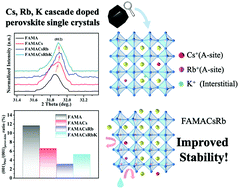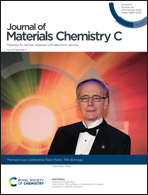Collective and individual impacts of the cascade doping of alkali cations in perovskite single crystals
Abstract
Alkali ion (Cs+, Rb+ and K+) incorporated hybrid perovskite polycrystalline films have shown great potential for obtaining highly efficient and stable perovskite solar cells. A study on the intrinsic influence of different alkali ions on perovskites is urgently needed to gain insights into the optoelectronic performance improvement. Single crystals with fewer defects can be ideal candidates for the study of intrinsic properties. Herein, for the first time, we prepared a series of perovskite (FA0.85MA0.15PbI2.55Br0.45) single crystals with Cs+, Rb+, and K+ cascade doping using the “inverse temperature crystallization” method and systematically characterized their structure and optoelectronic properties, as well as phase, humidity and thermal stability. Our work highlights the structure–property relationship, that is, diversified A-site occupation (especially the FAMACsRb system) can significantly promote the carrier transport behavior of perovskites, as well as achieving better thermal and humidity stability, while K+ doping degrades the intrinsic properties of perovskites, which is probably due to the interstitial occupation of K+. These findings deepen the understanding of the influence of alkali ion doping on the intrinsic properties of perovskite materials, which will provide an exemplary paradigm for further exploration.

- This article is part of the themed collection: Celebrating Tobin Marks’ 75th Birthday


 Please wait while we load your content...
Please wait while we load your content...